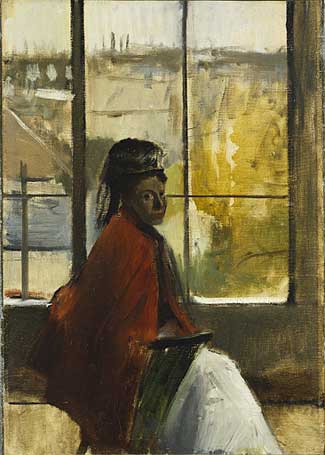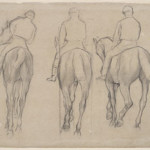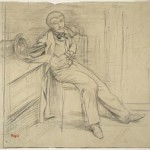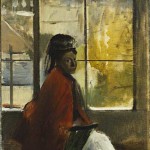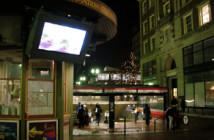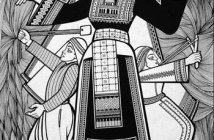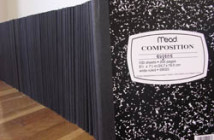Since I love almost every mark that Degas ever made, and anyone else with sensory organs and a passing affinity for Western art does too, this review probably best functions as an aid toward deciding whether or not to cross the Charles and pay $7.50 to see Degas at Harvard. The verdict is that yes, you should go. You’ll like it. Degas at Harvard is an exhibit with impressive breadth, and it manages to deliver a sum sense of the artist that actually feels revelatory.
The exhibit’s PR materials erroneously focus on the Fogg Art Museum’s bragging rights in having given Degas his only solo exhibition in a museum while he was alive, in 1911. Ignore this. It is surely just an invented, Guinness World Record-type category. Did museums tend to show contemporary art in 1911? Were there not salons and art fairs for that? At any rate, there is no evidence at all that Degas knew of the Fogg exhibit, so the show was not a redemptive experience for a neglected genius before his death. The blurb’s odd claim for the university’s singular vision raises the question of just what expectation visitors can reasonably bring to catalogue-raisonne-plumping reexaminations of single artists.
In this case, Degas’s works long ago proliferated in our nation’s museums and one senses one should know more about just what he was up to with his nudes and ballerinas with their low brows and flat feet. The show meanwhile does its part by avoiding charting the artist’s biography with sequential works. The focus is instead on working methods and technique, and Degas’s constant experimentation. The exhibit includes often quite disparate pieces to create a composite showcase of the masterly abilities that make Degas a Master.
On my visits, I was struck by an aesthetic of multiplicity in Degas’s art, one handled by the artist with complete felicity and warmth. On the back wall of the three room exhibit, for example, hangs a series of Degas’s familiar genre, women “after the bath” – their necks bowing with the action of drying, arms held gracefully akimbo, and backs swaying. In the middle of the series, the curators have placed two large, similarly scaled charcoal drawings side-by-side. As I stood there, it dawned on me (surprisingly slowly, actually) that the subjects’ body and posture were identical, save for the position and addition of an arm, chignon and towel, and Degas’s mood in his mark making. The drawings date from the same span of years, 1893-1898, and one is made on yellow tracing paper – tracing paper that had looks thick and opaque when we see it, either framed or standing alone in reproduction. Suddenly, I had visions of Degas’s working method as one occurring across a vast swathe of studio real estate: rapid, sequential drawings on reams of this yellow paper, the artist tracing and retracing the essential posture with assured strokes, while adding almost a bodhisattva of imagined gestures. The thick sensuality of the women’s trunk and rump (if you see the work, these terms will seem apt), seemingly erased of musculature, previously has always looked to me like clumsy inattention to women. It appears now as a reveling in the very freedom of tracing a well-honed contour. We are told that Degas often drew figures from memory, posed as if drawn from life.
Degas at Harvard contains more drawings and lithographs than paintings or sculpture (although one of the much beloved Little Dancer bronzes is included) and most are in the graphic vein rather than in the rich pastels that Degas is known for. On at least half these grayscale drawings, however, a jaunty Degas signature in red ink appears. The opening D has a highly consistent but peculiar orthography that does not match Degas’s pencil signatures. Each signature is the same size and proportion, and the red ink is very thick. Once I noticed their frequency, every new iteration punctuated my growing sense of Degas’s serial artistic practice. In fact, it seemed to me that this red signature was not signed, but was instead an artist’s stamp. Who would have applied the stamp? Was it a collector’s mark, or a simple convenience for the artist himself? A perfunctory google and JSTOR literature search turned up no information about the practice (I would welcome further information from readers about Degas’s red signatures.). However, the total message in these stamped drawings is clear. The established signature was always placed, always balanced. Each drawing is a carefully managed aesthetic field that integrates the marks of high volume production.
The show invites other interconnected musings, such as those concerning photography’s influence on the artist. Even the texts accompanying Degas’s sculptures mentioned Eadweard Muybridge (although said texts suggested that Degas’ stationery study of a dancer’s movements was an improvement, since it functioned in real-space)! In the show’s paintings meanwhile, grids and axes of reflection were apparent, especially in those with the highest finish, such as the ballerina-filled The Rehearsal. These apparatus helped the artist to combine elements from his sketchbooks, converting live action sketches to integrated scenes of figural schema. Despite this relational precision, the faces in the painting are left smeary, much like the heads in Degas’s experimental photographic portraits (also represented in the exhibit.) It is clear that the strongest influences in Degas’s articulation of his subjects are his drawings from Old Masters, and his photographs.
My favorite painting in the exhibit, as gorgeous in real-life as one could ever hope, is Alice Villette (1872). It is an exquisite tonal rendering of the Degas’s friend, seated before a high window. Each pane in the window’s aerial view of Paris is an entirely closed composition that is bounded by the vertical frames. The leftmost panes are most specifically rendered; one can see the hint of smoke stacks. The rightmost panes contain a set of strokes of muted color that verge, like all of Degas’s best brushwork, on the entirely abstract. The total landscape is not read as a continuous expanse of three-dimensional space, but rather more like a mise-en-scene of compelling contrasts and lushly dilute applications of paint. The somber visage of Alice Villette is darkened by her perch in front of the strong back lighting, as it would be in the light sensitive media of a photograph. Finally, in a highly saturated red, Degas has appended one of the most sensible-looking mouths I have ever seen in an Impressionist painting. Taking in these elements, one can understand why, when he was stranded at the dinner party of a friend during a snowstorm, Degas would have launched, as the exhibit text tells us he did, into a new series of bath drawings like so much parlor entertainment. This is a maestro at work, one fixing action and darkness and light, and prefiguring the still-nascent Paris cinema.
- Hilaire-Germain-Edgar Degas, Three Mounted Jockeys, Graphite and black chalk on tan wove paper, c. 1868-1870.
- Hilaire-Germain-Edgar Degas, Study for
- Hilaire-Germain-Edgar Degas, Alice Villette, Oil on linen canvas, 1872.
Links:
Harvard University Art Museums Degas website.
"Degas At Harvard" is on view August 1 thru November 27, 2005 at the Arthur M. Sackler Museum.
All images are courtesy of The Fogg Art Museum.

